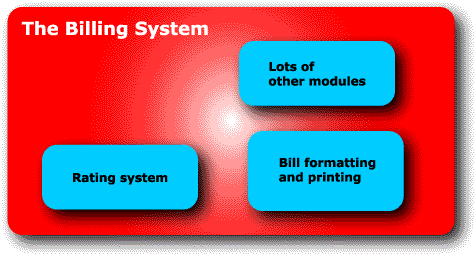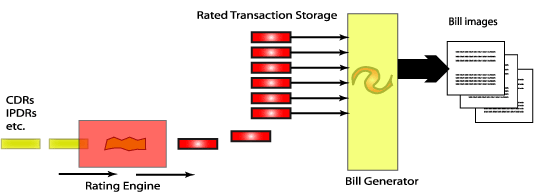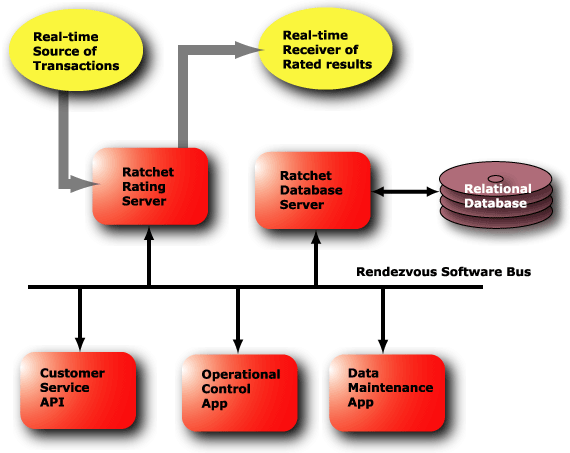RATING SUPPORT FOR REVENUE OPPORTUNITIES WITH GPRS & UMTS SERVICES
GPRS and UMTS bring new services to customers. These are services that improve our lives, entertain us, and give us value. This report describes the revenue opportunities that arise and the ways that rating software needs to support them.
GPRS and UMTS are acronyms for new wireless data services that bring the Internet to portable communications and computing devices. GPRS (General Packet Radio Service) is a second-generation (2G) wireless service that will be used predominantly through a protocol called Wireless Applications Protocol (WAP). This is a simplified browsing and interaction protocol to work on the limited displays and input interfaces of handheld wireless phones.
UMTS (Universal Mobile Telecommunications System) is a third generation (3G) wireless service that is a TCP/IP based system bringing all the power of the Internet to wireless devices. The devices using this service are more powerful and work without the limitations of the WAP protocol.
The impact of GPRS and UMTS continues the revolution in communications and services started with the Internet and cellular phones. The following table shows the projected worldwide growth of users of PCs, Cable TV, and Mobile Phones.
|
PC |
CABLE |
Mobile |
|
|
1998 |
298 million |
199 million |
290 million |
|
2003 |
550 million |
260 million |
1,000 million |
|
By 2005 thirty percent of traffic is data; more mobile handsets connected to the Internet than PCs |
|||
Figure 1. Projected growth
and change of Internet usage.
(Source: Cisco Systems, Webcast by Jon Shantz, Vice President of Wireless Market
Development)
“With the turnover rate on wireless communications devices from old ones to new ones, by 2003 half of all mobile phones will be WAP or better protocol device. This makes wireless the most common method of connecting to the Internet” – Jon Shantz, Vice President of Wireless Market Development, Cisco Systems, Webcast 17 February 2000
Rating has been a function in service provider’s infrastructure for many decades. Wireline telephone companies have defined this traditional role. During the last fifteen years, their role has been modified by the appearance of wireless companies. I’ll describe its role below.
The traditional high-level business functions in a service provider’s business cycle are simple. These are shown below.

Figure 2. The three basic business functions
These basic business functions are supported by software systems. The function “Provide Services” is performed by the communications equipment and their Operations Support Systems (OSS). The function “Bill for services” is performed in modern businesses by the Billing System. This is also called the Business Support System (BSS). The process of supporting “Get Paid” is usually part of the BSS also, but it’s too important to exclude from the diagram above.

Figure 3. A simplified component diagram of a billing system
This diagram shows the billing system as an organized group of software functions. Within this group are functions for rating and for bill production (formatting and printing).

Figure 4. The flow of CDRs and IPDRs through rating and then billing
The Rating Engine works in cooperation with the rest of the Billing System. Call detail records (CDRs) and Internet Processing Detail Records (IPDRs) come from your network devices and mediation systems to the Rating Engine. The Rating Engine calculates the proper charge for the transaction received and then guides it into position for use by the Bill Generator. When the bills are prepared the Bill Generator takes all the records for a particular bill and creates the bill. The bill creation involves the calculation of taxes and of the discounts or surcharges that require knowledge of all of the customer’s activity. If a customer receives a discount based on their total spending, then you must wait until the end of the period to calculate it. Discounts that can be calculated when you look at a single transaction are calculated by the Rating Engine.

Figure 5. The steps of transformation from raw transaction record into chargeable output events
The Rating process is more complex that it might first appear because the incoming transactions go through several transformations.
- Records must be validated
and then matched with other records to describe the services rendered. This
creates transactions.
- Transactions must be
evaluated against information about the customer’s rate plan to determine
what billable events occurred. The same transactions for one customer rate
plan may generate different billable events than from another customer’s rate
plan.
- Billable events are
then “rated” to set the price for the billable event. The rating also includes
discount and/or surcharges that are applied at a single transaction level.
- Rated events are lastly formatted in the output format(s) employed by the systems that receive the rating output. The output normally goes to a storage spot for use by the Bill Generator. It may also go to fraud management systems, margin analysis systems, and roamer billing applications.
The above steps describe the actions taken when there are no problems with the data or the rating process. The actual processing is complicated by the records that aren’t valid, by the records that do not have their mates needed to create a transaction, and by incomplete rating data. The problem is complicated further by the need to be able to re-rate transactions already stored in the rating storage on demand from the customer service representative or a revenue assurance manager.
RATING ENGINE IMPACT
The Rating Engine must process all the traditional transactions of a communications provider. It must also deal with all the operational complications that the Real World brings with it.
GPRS and UMTS bring new sources of revenue to the wireless services provider. They also increase the traditional revenue sources of the wireless provider. The following table points out the projected impact from the wireless Internet based on the experiences of an existing European service provider.
|
Wireless Internet effect |
|
|
Measure |
Internet Effect |
|
Churn |
Reduced by 20% |
|
Average Minutes |
Increased by 80% |
|
Average Revenue |
Increased by 70% |
|
SMS per month |
Increased by 400% |
|
Based on GSM and Internet service bundles of leading European operator |
|
(Source: Cisco Systems, Webcast by Jon Shantz, Vice President of Wireless Market Development)
Figure 6. Projected impact of wireless Internet.
REDUCED CHURN
The reduction of churn has a dramatic impact on the cost of customer base growth and maintenance. The replacement of lost customers from churn remains a significant component of the costs of being a service provider. A twenty percent reduction in this cost turns into a several percent point increase in per share earnings. Alternatively, this lowered cost of customer acquisition may be converted into lower service prices and increases in customer base growth.
Reduced churn also increases customer lifetime value and the willingness of service providers to make up-front investments in subsidizing new communication devices for GPRS and UMTS.
INCREASED MINUTES OF USAGE
Increases in minutes of usage represent the transmission time representing the Internet usage. With GPRS and UMTS these are delivered in different ways, but we can ignore the protocol difference and focus on the overall increase of use. Increasing use of minutes permit greater investments in network equipment. With more network equipment, the quality of service from wireless providers also improves. The interaction between increased usage and increased quality of service is serendipitous. The more you use it, the better it gets.
Increased minutes of usage also lower the overall costs of providing service with scale advantages. These increase profitability and/or permit the lower of prices.
INCREASED AVERAGE REVENUE
Increased usage also increases revenues when charges for usage remain relatively the same. This sounds great from the point of view of financial returns, but it connects to another more important lifetime customer value issue. The more minutes a customer uses your service the greater loyalty is developed and the greater resistance there is to customer churn.
This projection of increased usage is a result of the increased value received by customers. It’s not based on population growth. The increased value comes from the multiple parallel forms of communications that mobile Internet service provides. Customers will be able to employ voice, paging/SMS/instant messaging, e-mail, chat, and web access at any time and in concert.
This bundle of communications services adapts to the social and cultural needs of customers. Some customers will employ all the methods of communications. These “multi-channel” individuals may even communicate on several channels in parallel. For the customer who wishes to employ only one of the “channels”, these new communications services continue to serve their needs.
INCREASED SMS USAGE
The increase of SMS usage seen was probably much bigger than our European service provider expected. I believe that it is the early wave of the increase of data communications that come with GPRS and UMTS.
RATING ENGINE IMPACT
All these increases in revenues and usage affect the workload for the Rating Engine. As the usage increases, the number of transactions to process increases. Rating engines must scale up to tens of millions of transactions per hour.
Personalization of services is an important component of the new service that will appear. MyYahoo.com and MySAP.com are given as examples of these personalization trends.
The personalization may continue in the GPRS/UMTS environment in bundling of service for each person. For example, caller identification information is provided with voice call received in this environment. Further personalization might include immediately displaying location information for the caller either based on their traditional phone number location. This phone number location is customized to inform the call recipient of the actual location of the caller when they are mobile. Providers of services can then suggest solutions based on the caller’s location.
LOCATION, LOCATION, LOCATION
Retail businesses follow the rule that the most important aspect of the business is “Location, Location, Location”. There is no doubt that a good location increases the success of a retail business. This same rule applies to the new services available with the Mobile Internet.
Location information is a new component of the services mix that support both push and pull information communication technologies. Marketers are excited about offering promotions to people who come near their business locations in a “push” environment. If customers turn off push communications, then using the location information in the “pull” environment permits timesaving personalization of services offered.
The personalization of services permits a proliferation of new rating models. The entry into the provision of Internet services will bring communication services providers into the world of “Internet Time”. In the Internet Time, product creation and replacement rates are four times faster than the typical creation and replacement rate of communications. The Internet averages six months to create and replace while communications averages two years.
RATING ENGINE IMPACT
The Rating Engine must support many different rating models and provide for the easy implementation of unanticipated models. Rating Engines are usually either table-driven or rule-based. Table-driven rating engines are typically the older technology. Table-driven technology is easier to implement with the COBOL programs used on mainframe computers.
The table-driven rating engine uses predefined tables of data that express the rating plan desired. Table-driven permits the easy implementation of different rating models. It is usually processes more transactions per hour than a rule-based rating engine. It fails when the rating plan employs an unanticipated rating model. When a new kind of rating model is required, you must modify the data table definitions and go to your programmers to change the program code. This often results in months of delay in getting a new rating model implemented.
Rule-based rating engines employ program-like rules that guide the rating process. The rules permit you to include new input data that is only employed in a single rate plan. You can think of rule-based rating as a programming language for expressing rating models. Rule-base raters must interpret the rules as they are processed. This gives the performance advantage to the table-driven rater in records processed per hour. The strategic advantage goes to the rule-based rating engine because new rating models can be implemented in days rather than months.
Rules-based rating engines are required for the new communications services that come with GPRS and UMTS. The rate of change in the business is too fast to employ at faster rating engines, but that leaves a service provider falling behind his competitor’s product offerings. The performance advantage of table-driven raters is compensated for by the continuing increases of computer speed and the relatively low cost of additional computing resources. The cost of increased computing resources is very low compared the earning potential of new products.
BITS ARE BITS, AREN'T THEY?
This is a common attitude toward the provision of services on the Internet. The historical community of engineering/scientific users that founded the Internet started this idea. Their egalitarian view of Internet services was continued with the monthly subscription service sales approach taken by Internet Service Providers in much of the world.
This view clashes with the wireless provider view that radio bandwidth is an expensive and limited resource. Service providers have traditionally charged by the minute or message for the services provided. They just don’t accept an unlimited usage plan where you can pay a single fee and use all the services you want.
When I hear this egalitarian view, I visualize a world where people say molecules are molecules and the value of a pile of sand should equal the value of an integrated circuit. Suddenly the fantasy collapses. I know better. I value certain arrangements of molecules for the benefit they give me.
The same will happen with bits delivered by the Internet. I already value certain bits more than others. When a favorite author publishes a book, I’m willing to pay more for it. When information permits me to invest wisely, I value it. When the photos of my children arrive in the e-mail box of their grandparents, they value it highly.
The VALUE dimension is fundamental to the exchange of goods. For example, I pay for phone calls based on the amount of time I can speak to my family. This is the dimension used for valuing the conversation. If the marketers at the telephone company could measure my happiness from the call and they could deliver that happiness, they could rate based on that happiness measure and I’d be excited about paying them more for “happiness” from my phone calls. For those calls, happiness is the component I value from the call.
When GPRS and UMTS deliver all these new streams of communication, some of them are going to be priced on cost parameters (like minutes, megabytes) and some on value parameters (happiness, transactions processed, used cars found meeting my needs).
Moreover, the context of the value is personalized. Inflatable boats were extremely valuable in East Berlin before the Berlin Wall was erected to those who wished to flee.
These new revenue sources are added to the old revenues sources. Solutions for GPRS and UMTS must rate voice calls, paging (SMS), and all the new services from the Internet.
These new revenues sources are measured in new units of measure. Simple data transfer may be measured in megabytes or e-mails. Specialized financial reporting may be measured in graphs or alert messages. Adult entertainment may be charged by the image.
Application Service Provider (ASP) service is measured in reports generated, transactions processed, or even several of these different units of measure.
UNITS OF MEASURE
The new services change the requirements for rating. Previously, rating engines charged for communications services that were all measures by duration. The price per minute varies by the origin, destination, time of day, day of week, and distance. It was similar to having a butcher shop where everything is measured in kilos/pounds, but the charge for any amount of weight varied by the kind and cut of meat purchased. If you had a scale, you could calculate the price of every product.
The new services add many new products that are measured and valued by different units of measure. Some are measured by megabytes transferred, some by services performed (e.g. graph displayed, transaction processed), and many are sold like prepackaged food (a price for each).
RATING ENGINE IMPACT
The Rating Engine for GPRS and UMTS must provide the ability to measure and charge for services in the unit of measure appropriate to the service provided. Each rate plan must be able to employ its natural unit of measure. Some service will require the use of more than one unit of measure for the service. For example, a store-and-forward fax transmission system may charge for both the size of the fax transmitted and the duration that it must be stored before it is delivered.
- Solutions
for GPRS/UMTS must continue to support the rating of older services. These
will remain a large portion of the revenue stream for service providers.
- Rating solutions must be prepared
for much larger numbers of transactions
- Rating solutions must support
personalized rate plans.
- Rating solutions must
support units of measure appropriate to the service provided.
- Rating solutions must be rule-based to support the rate of change in product offerings.
Service Level LLC provides the Ratchet™ Rating system to support the needs of the wireless Internet marketplace. Each of the of the requirements above is satisfied by its rule-based solution.

Figure 7. The components of the Ratchet™ Rating System
You can learn more about the Ratchet Rating solution at http://www.servicelevel.net/. The product and its implementation support team make a success of your implementation. You can contact our representatives at mailto:sales@www.servicelevel.net
div>
